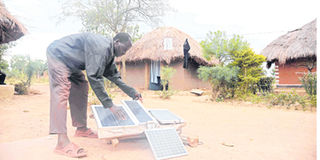Launch of $19m solar plant brings hope to rural Uganda

Robert Otala of Alaki Village in Soroti District, about 300 kilometres northeast of the capital Kampala, checks on his solar panels that he uses for home purposes. PHOTO | AFP
What you need to know:
- Another shop owner, Richard Otekat, 37, has to pay a neighbour hourly to use his generator during blackouts as he can’t afford to buy one himself, while others simply go without.
- However residents of the town, surrounded by thatched huts, rivers and grasslands, hope a new solar plant, which went into operation last week, will bring an end to their electricity woes. The $19 million (18-million euro), 33-acre solar plant -- the first of its kind in East Africa -- can produce 10 megawatts of power that is fed into Uganda’s national power grid.
Soroti, Uganda. When power goes out in the rural town of Soroti in eastern Uganda, store manager Hussein Samsudin can only hope it won’t go on so long it spoils his fresh goods.
Another shop owner, Richard Otekat, 37, has to pay a neighbour hourly to use his generator during blackouts as he can’t afford to buy one himself, while others simply go without.
However residents of the town, surrounded by thatched huts, rivers and grasslands, hope a new solar plant, which went into operation last week, will bring an end to their electricity woes. The $19 million (18-million euro), 33-acre solar plant -- the first of its kind in East Africa -- can produce 10 megawatts of power that is fed into Uganda’s national power grid.
The project is crucial as Uganda seeks new ways to bring electricity to the 80 per cent of its 40 million-strong population that does not have access to power.
“We are an agricultural economy, the majority live in rural areas,” said Ziria Tibalwa Waako, acting head of the national electricity regulator, Uganda Electricity Regulatory Authority.
She said the main source of energy available to most Ugandans is firewood, while others use charcoal and gas, as electricity is just too expensive at around 15 cents USD a unit.
It is hoped the introduction of power from the solar plant into the national electricity grid -- fed by hydro power and independently run diesel generators -- will bring the price down.
“Power is costly. It eats into our profit margin,” Otekat told AFP.“Unfortunately when power is not there for like six hours that is an automatic loss we are expecting,” said fellow shop manager Samsudin, tired of melting ice-cream and meat going off.
“The plant will provide clean, low-carbon, sustainable electricity to 40,000 homes, schools and businesses in the area,” said Christophe Fleurence, vice president of Eren Renewable Energy, one of two private companies operating the plant, funded by EU partners.
He said that Soroti, some 300 kilometres (186 miles) from Kampala, was “where the sun is brighter than anywhere in Uganda.”
Uganda has one of the lowest electrification rates in Africa, according to Climatescope, the clean energy country competitiveness index. While the solar plant could ensure businessmen like Samsudin and Otekat have a more steady power supply, those who aren’t yet connected to the national grid or cannot afford electricity at all, are unlikely to benefit soon.
And the wait for electricity can prove dangerous. “People use firewood to light their houses because kerosene is very expensive to some households. We had cases of people’s homes burnt especially as they slept or when left unattended to,” said local official Edward Esegu.
Many African nations, and developing nations elsewhere in the world, are taking the lead in renewable energies by turning to solar as a first step in their power arsenal.Climatescope said that clean energy investment had doubled from 2014 to 2015 to reach $5.2 billion in the 58 emerging markets it surveys. (AFP)




